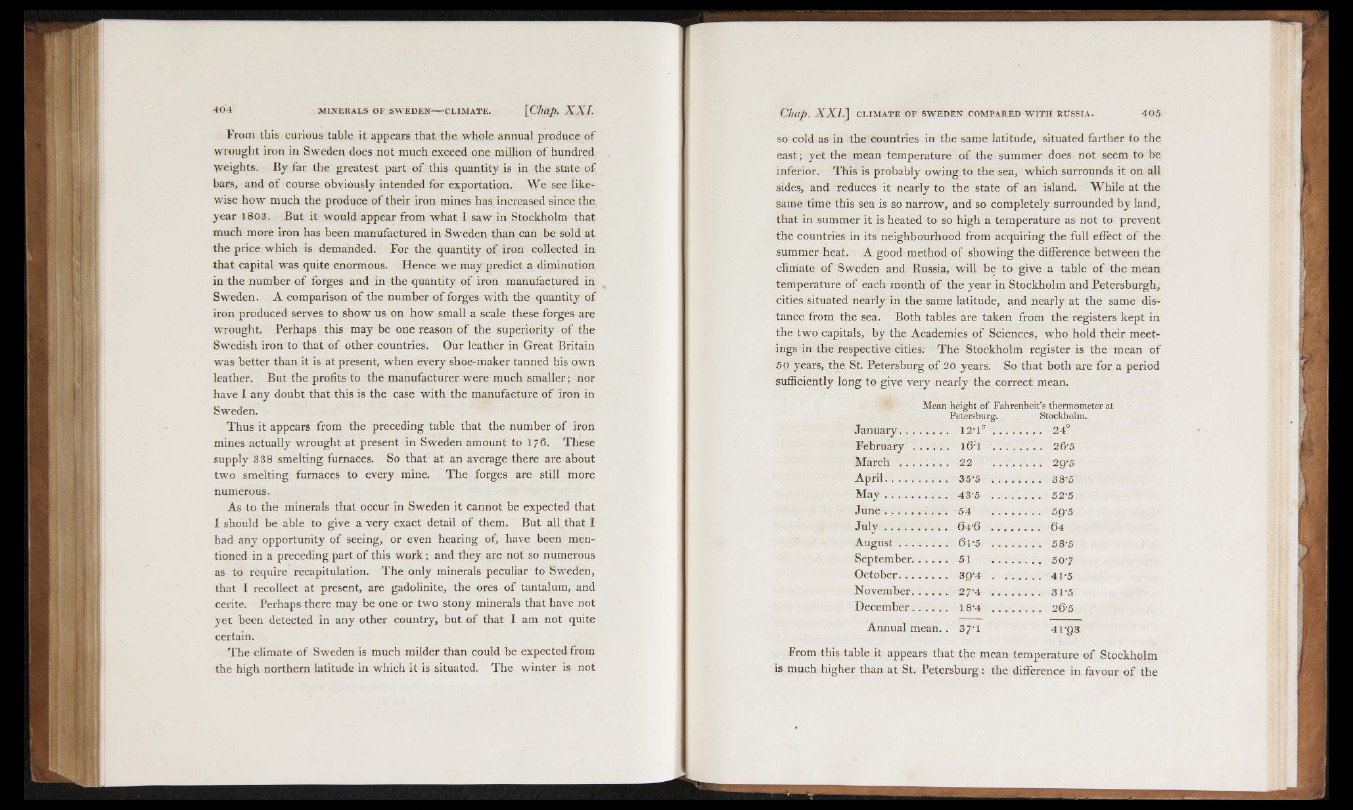
From this curious table it appears that the whole annual produce of
wrought iron in Sweden does not much exceed one million of hundred
■weights. By far the greatest part of this quantity is in the state of
bars, and of course obviously intended for exportation. We see likewise
how much the produce of their iron mines has increased since the,
year 18 0 3. But it would appear from what I saw in Stockholm that
much more iron has been manufactured in Sweden than can be sold at
the price which is demanded. For the quantity of iron collected in
that capital was quite enormous. Hence we may predict a diminution
in the number of forges and in the quantity of iron manufactured in
Sweden. A comparison of the number of forges with the quantity of
iron produced serves to show us on how small a scale these forges are
wrought. Perhaps this may be one reason of the superiority o f the
Swedish iron to that of other countries. Our leather in Great Britain
was better than it is at present, when every shoe-maker tanned his own
leather. But the profits to the manufacturer were much smaller ; nor
have I any doubt that this is the case with the manufacture of iron in
Sweden.
Thus it appears from the preceding table that the number of iron
mines actually wrought at present in Sweden amount to 176. These
supply 338 smelting furnaces. So that at an average there are about
two smelting furnaces to every mine. The forges are still more
numerous.
As to the minerals that occur in Sweden it cannot be expected that
I should be able to give a very exact detail of them- But all that I
had any opportunity o f seeing, or even hearing of, have been mentioned
in a preceding part of this work; and they are not so numerous
as to require recapitulation. The only minerals peculiar to Sweden,
that I recollect at present, are gadolinite, the ores of tantalum, and
cerite. Perhaps there may be one or two stony minerals that have not
yet been detected in any other country, but of that I am not quite
certain.
The climate of Sweden is much milder than could be expected from
the high northern latitude in which it is situated. The winter is not
so cold as in the countries in the same latitude, situated farther to the
east; yet the mean temperature o f the summer does not seem to be
inferior. This is probably owing to the sea, which surrounds it on all
sides, and reduces it nearly to the state of an island. While at the
same time this sea is so narrow, and so completely surrounded by land,
that in summer it is heated to so high a temperature as not to prevent
the countries in its neighbourhood from acquiring the full effect o f the
summer heat. A good method of showing the difference between the
climate of Sweden and Russia, will be to give a table o f the mean
temperature o f each month o f the year in Stockholm and Petersburgh,
cities situated nearly in the same latitude, and nearly at the same distance
from the sea. Both tables are taken from the registers kept in
the two capitals, by the Academies o f Sciences, who hold their meetings
in the respective cities; The Stockholm register is the mean of
50 years, the St. Petersburg of 20 years. So that both are for a period
sufficiently long to give very nearly the correct mean.
Mean height of Fahrenheit’s thermometer at
January.............
Petersburg.
. 12 -1 °___
Stockholm.
___ 24°
February . l6"‘l . . . . ___ 26‘5
March . . . . . . . . 22 . . 1. . . . . 29-5
April.................. . 35'5 . . . . . . . . 38'5'
Ma y .............. . 43'5 . . . . . . . . 52-5
June.................. ; 54 . . . . ----- 59-5
July . . . . . B . . . 64-6 . . . .
A u gu s t............. . 6 l "5 . . . . . . . . . 58‘5
September......... . 51 ____
October............. . 39'4 . . . ___ 41-5
November. . 27'4 ___
December......... . 18-4 ___
Annual mean. . 3 7 1 4 1-93
From this table it appears that the mean temperature o f Stockholm
is much higher than at St. Petersburg: the difference in favour of the